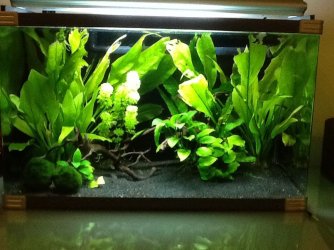That is a very nice aquascape, ellena, I like that. And now that I've seen it, I can go a little further. I would definitely increase the
Trigonostigma hengeli to 9-10, for their betterment. This species will always be better with a few more; I like this species best of the three similar
Trigonostigma rasbora, and I've had all three over the years. I know you find them uninteresting, but adding a few more might help to increase their activity, though as I said previously this is not an active swimming species. But they will be "happier" with more pals, and that counts for something. Mine are going through spawning motions but they still remain in a close group centre-tank except when feeding.
In your example of cardinals v danios, I assume this is because of the swimming room danios need.
Yes, that was my intention. But it goes farther. When fish are denied something they are inherently programmed to expect, they will be more likely to be under stress and this impacts negatively on the tank's biology more than if the environment was more suited to the needs of the fish. Danios are swimming fish, so they should have space, and they will be healthier. Cardinals on the other hand are not active swimmers, behaving more like your rasbora, so one can have more of them because such fish tend to occur in much larger groups. So providing more in this instance actually has less effect on the biololgical system than too few. It's not an enormous difference by any means, but everything does add up.
You can up the numbers within a species because they don't need their own territory? Do all fish have a territory of some kind, or need their own space within a tank?
Territory can be very significant with some fish more than others, so this may enter the equation too. But with most (but certainly not all) of the characins and the "rasbora" cyprinids, numbers are primarily a safety issue for the fish; the more there are, the safer they feel. They do have interactions though; I regularly see the males of many of my tetras and rasbora challenging/displaying/playing, whatever it may be and most likely all three, by two of them, sometimes three, sidling up, turning at an angle, fins fully erect, "shivering" side by side. Pencilfish do this a lot, and my Black Ruby Barbs are forever sparring, two males with fins erect chasing each other in a circle very rapidly, and for several minutes, sometimes hours, on and off. The more there are in the group, the more natural this becomes.
Territory does come into play with the Honey Gourami; male gourami are very territorial, depending upon species it can vary in the aggressiveness, but gourami and cichlids are very similar in this respect. And some male gourami will drive females very hard, which is why one male with two females is often suggested; depends again upon species. The females must have space to escape the attentions of the male, or they can be seriously weakened and even killed. Honeys are not so bad in this, but males can become quite territorial when spawning. And at 2 inches (5 cm, some sources say up to 7 cm) this is not really that small of a fish. So this too affects my thinking on fish in a 15g.
So, I'm seeing there are different definitions of overstocked-
Too much fish mass for the filter to handle leading to poor water parameters
Tank dimensions unsuitable for size/activity level of species
Incompatible species housed together
Too many different species in one tank (the issue with my stocking?)
I think those last 2 might better be called mis stocked.
Yes on the factors; no in your case on the species. Aside from the frogs of which I know next to nothing, the gourami and rasbora are perfect tankmates. You could add other rasbora species (though I still would up the hengeli), and some of the quieter characins would work here too, if the space limitations were not an issue.
Fish release pheromones and allomones, and these cannot be removed with filtration (plants can handle some, but this is only 100% effective in ratios of very few fish to masses of plants in larger water volumes) but only water changes. Pheromones are "read" by other fish in the species, and allomones are "read" by other species. These are chemical signals that can have all sorts of meanings, from initiating spawning, to aggression, to locating food, etc. And these are a major source of stress signals that can seriously impact other fish. As a simple example of this, an aggressive fish is sending out this signal and the other fish are picking it up, which increases their level of stress. Even if no physical interaction occurs, the effect can be just as damaging to the fish. I frequently hear new aquarists saying that there are no problems with their Tiger Barbs and angelfish, but the fact is there almost certainly is serious trouble, because the barbs are sending out signals and the angelfish are picking them up and getting stressed.
Byron.



 I was starting to wonder if my posts were showing up! Fish behaviour is something I'll have to research in future, though I've not seen much info on it.
I was starting to wonder if my posts were showing up! Fish behaviour is something I'll have to research in future, though I've not seen much info on it.